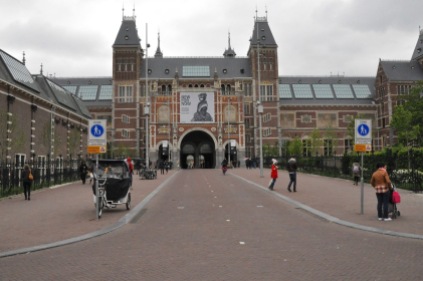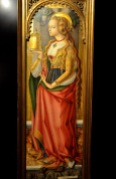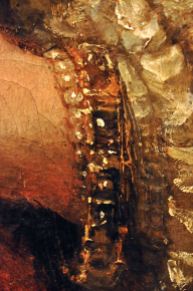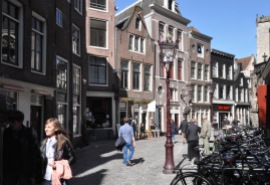OK OK, I’ve shown a bunch already, but there is so much more wonderful to see at Amsterdam’s Rijksmuseum. This last (promise!) post on the Rijksmuseum is mostly on the Impressionists, and Henri Matisse in particular; the museum had a special exhibit on his career, particularly his latter years, with paintings on loan from throughout the world. It’s interesting to see his artistic development, so let’s start with him!
It’s 1895, and Matisse has an academic style – a mostly realistic representation of objects
and a subtle, dark palette, as illustrated by the first two paintings above. His studies of nudes are also classical, as shown in the last picture above. However, Matisse has a ceaseless quest for innovation. He becomes acquainted with Impressionism, and from an extended visit to the island Corsica and its Mediterranean light, his palette is transformed to bright colors. He dabbles in the Pointillism of Seurat and Signac, then develops a new
approach, creating areas of pure, super-saturated color, a style that came to be known as Fauvism, and of which Matisse was one of the main leaders. As the art world entered into the modern times of Picasso and Cubism, Matisse begins to work in his characteristic “pure line”; he does countless studies of the female form, executed in a few seemingly
effortless lines, and produces paintings that reduce shapes to their most elementary forms. During the horrors of WWI, Matisse returns to Paris and paints in highly abstract,
geometrically constructed works. Commissioned to do stage and costume designs for a ballet, Matisse continues with his geometric patterns. In search of the most effective compositions, he cuts shapes out of paper and arranges them in patterns; the process impresses him, and later in life he exclusively returns to this technique (as we’ll see!).
Following a trip to Morocco where he encountered the world of the odalisques (concubines or harem slaves, particularly in Turkey), Matisse features them in his paintings and returns to a more figurative, naturalistic style. In his words, “I make odalisques so that I can paint nudes.” Hmmm. We’ve noticed this propensity! Increasingly he incorporates
props and has his subjects pose in clothing made from expensive fabrics in order to create a dream-world of exotic women in seductive poses. That last painting, you will notice, is a ringer from Picasso. It’s a tribute to Matisse, done shortly after his death: “When Matisse died, he left his Odalisques to me.”
Below are charcoal/pencil sketches, one of his assistant Lydia Delectorskaya (who helped
make many of the costumes for his models), one sketch from an envelope, and the other clearly a self-portrait (as you can see from the subsequent photo).
The last phase of Matisse’s explorations as a painter occurs following the German invasion of France and Matisse’s move to a reclusive life near the French Riviera. He
adopts a flat style with simplified lines and dazzling color.
The most interesting part of the Matisse exhibit was his transition to cut-outs. As noted earlier, his use of cut-outs in creating costume designs had intrigued him. He further played with this technique in his design of Dance II, a triptych mural for the Barnes
Foundation in Philadelphia (which we’ll show you in a future blog), and in his design for a cover for the journal Verve, a modernist Parisian art magazine. Now, in the mid 1940’s, he sees this technique in an entirely new light, and he dedicates himself to it. Matisse was one of the few Impressionists/Fauvists/Modernists who continued to innovate well into old age. He was the first to employ cut-outs on a grand scale, and they are a vibrant grand finale to his life. Some early – can we call them paintings? – are shown below.
The transition from painting to cut-outs is actually rather seamless. Check out the work below, Mimosa, and compare it to the fern in the painting Interior with Black Fern, the
last painting shown 3 panels earlier.
Matisse obviously loved the female form, and of course he goes back to his nudes, as
shown above. Gradually his cut-outs expanded to a monumental scale, as shown below, although by now Matisse is 84 and in a wheelchair, needing an assistant to mount the
cut-outs. That last work, The Parakeet and the Mermaid, Matisse says “I have made myself a little garden all around me where I can walk.”
 This last piece, to the left, was done the year of his death (1954). It’s again a design for the cover of the journal Verve; Matisse did a number of covers for them. The Fauvist tendencies are still there, and still interesting.
This last piece, to the left, was done the year of his death (1954). It’s again a design for the cover of the journal Verve; Matisse did a number of covers for them. The Fauvist tendencies are still there, and still interesting.
One of the delights of this exhibition on Matisse was the juxtaposition of his work with other artists of his time, allowing one to see how they influenced each other (such as the Picasso shown earlier). Duplicating that exhibition in this post would be too much, but I will show you some of the paintings of these Impressionists and Modernists, which I’ll group not by artist but by year. We’ll start, as did the exhibit, with paintings that predate Matisse. They’re too good to miss!
Here are a few early Impressionist paintings:
I really liked the picture by Jongkind, The House of Master Adam Billaud at Nevers. I was not familiar with Jongkind; he’s regarded as a forerunner of Impressionism, a link between the works of Corot and Monet (and Monet was one of his pupils).
And here are some Van Gogh paintings (mind you, Amsterdam has a whole museum devoted to Van Gogh, so there are only a few Van Gogh paintings at the Rijksmuseum).
OK, just a few more pre-Matisse paintings:
The following paintings are from Matisse contemporaries:
As are these:
 I’ll end with a later, cute work by William Copley, Lady Chatterley’s Horse, from 1960.
I’ll end with a later, cute work by William Copley, Lady Chatterley’s Horse, from 1960.
As noted in the previous post, there is more to the Rijksmuseum than paintings, and I’ll share a few more of these treasures with you. The first, shown on the first line below, is an amazing folding screen called Guineafowl, made by G. W. Dijsselhof in 1894 from cotton batik (the technique involves drawing on cloth with wax; when dyed, the drawing is left uncolored). Batik was the
Dutch contribution to art nouveau. Although reflections from the protecting glass made photography very difficult, I think you can still see how amazing this work is. The two other wood items are beautiful in their own way.
The fascinating items below are all ceramic.
I’ll close with this work of art, shown below. How interesting to find this allusion to
American politics in an Amsterdam museum!
Alas, I have a sad story to tell. Also in Amsterdam is the Van Gogh museum, which we thought was truly fabulous. I did not realize he only painted for 10 years (!). His evolution from his first crude paintings (The Potato Eaters) to his subsequent style is remarkable. We loved this museum, and I had some amazing pictures to show you. Past tense. They unfortunately got overwritten. If you get to Amsterdam, don’t miss that museum.
Next post, Paris.















































































































































































































 OK, off to the good stuff! Let’s start with one of the highlights of the museum – one of the most famous Dutch Golden Age paintings from the greatest portrait artist of the time, Rembrandt van Rijn’s Night Watch, 1642. It’s sufficiently important to have its own room, and it’s placed just so; the painting is at the visual center at the end of the hall in this picture. The Night Watch is a group portrait of the city’s civic guard getting ready to move out. Until this painting, group portraits showed people sitting or standing stiffly. Not here! The picture is an action shot; motion is everywhere. Furthermore, details of the
OK, off to the good stuff! Let’s start with one of the highlights of the museum – one of the most famous Dutch Golden Age paintings from the greatest portrait artist of the time, Rembrandt van Rijn’s Night Watch, 1642. It’s sufficiently important to have its own room, and it’s placed just so; the painting is at the visual center at the end of the hall in this picture. The Night Watch is a group portrait of the city’s civic guard getting ready to move out. Until this painting, group portraits showed people sitting or standing stiffly. Not here! The picture is an action shot; motion is everywhere. Furthermore, details of the






























































































 undergoing many alterations until its final form in the 1500’s, shown here (now used for non-religious purposes). The Oude Kerk became too small to serve the expanding Amsterdam, so a new basilica was started about 1400, dividing Amsterdam into 2 parishes – and subsequently centuries of competition. The Nieuwe Kerk was damaged by fires in 1452 and restored to its final late Gothic structure, shown in the pictures below.
undergoing many alterations until its final form in the 1500’s, shown here (now used for non-religious purposes). The Oude Kerk became too small to serve the expanding Amsterdam, so a new basilica was started about 1400, dividing Amsterdam into 2 parishes – and subsequently centuries of competition. The Nieuwe Kerk was damaged by fires in 1452 and restored to its final late Gothic structure, shown in the pictures below.





























 let’s not forget the red-light district (where photos are not encouraged) – but let’s close this post with a quick look at Amsterdam’s ambiance, which is quite delightful. The ubiquitous canals and bridges of this large city divide it into domains that give it a small-town feel that’s palpable. And yes, there are touristy shops around – flowers, bulbs, china, wooden shoes – but they feel like part of the town rather than a tourist mecca. I hope the pictures below give you that feel.
let’s not forget the red-light district (where photos are not encouraged) – but let’s close this post with a quick look at Amsterdam’s ambiance, which is quite delightful. The ubiquitous canals and bridges of this large city divide it into domains that give it a small-town feel that’s palpable. And yes, there are touristy shops around – flowers, bulbs, china, wooden shoes – but they feel like part of the town rather than a tourist mecca. I hope the pictures below give you that feel.








